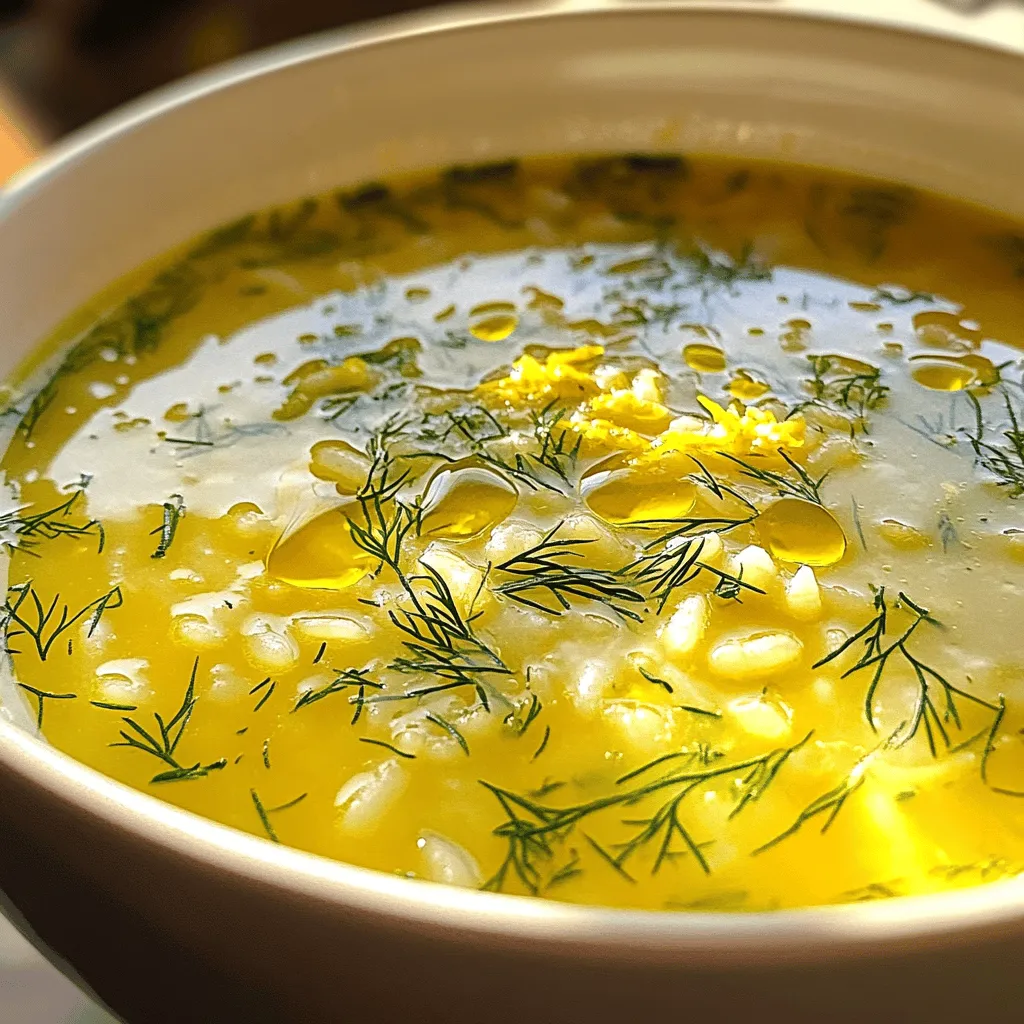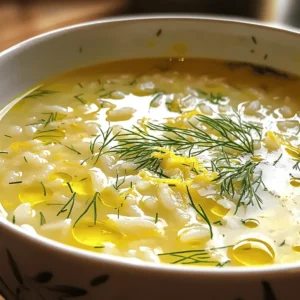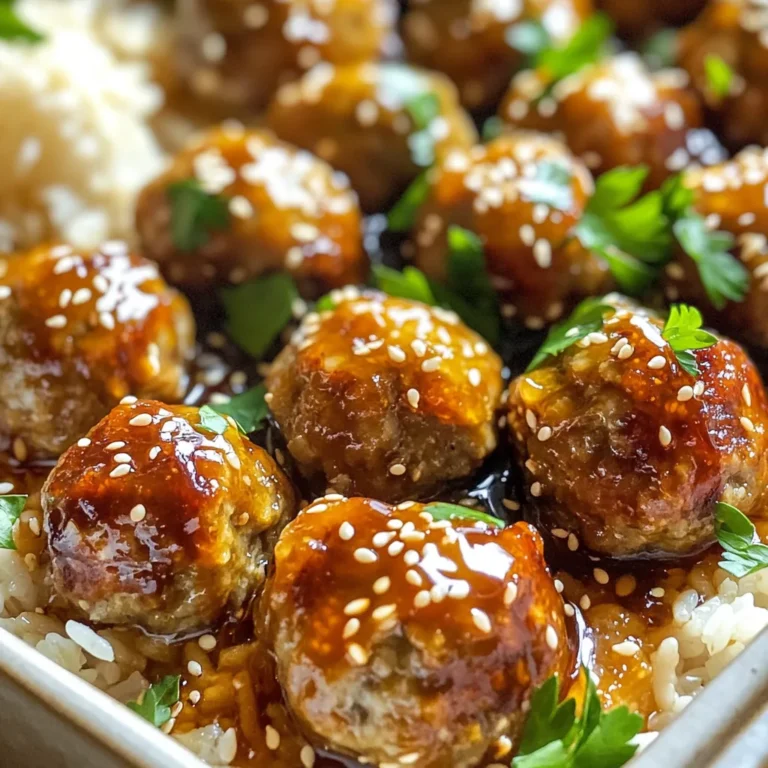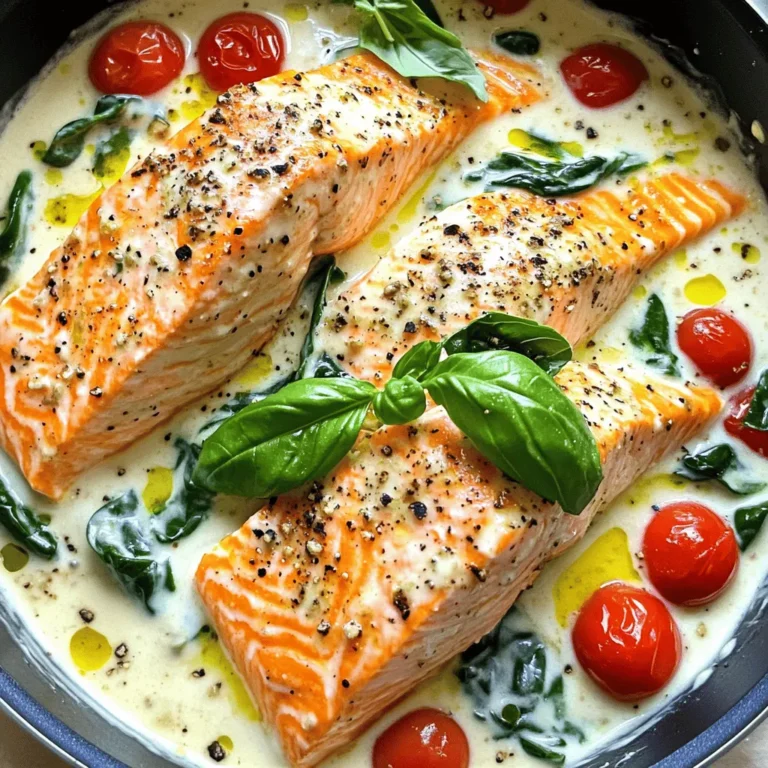Greek Lemon Rice Soup Comforting and Flavorful Recipe

If you’re craving a dish that’s as comforting as a warm hug, look no further than Greek Lemon Rice Soup. This delightful recipe blends savory broth with bright lemon and tender rice, creating a balance of flavor that satisfies every time. In this article, I’ll guide you through each step, from choosing the best rice to adding the perfect touch of herbs. Let’s dive into this delicious journey of taste!
Ingredients
Let’s gather the needed ingredients to make this delicious Greek lemon rice soup. Each item plays a key role in creating the perfect balance of flavor. Here’s what you need:
- 1 cup uncooked rice (jasmine or basmati)
- 4 cups chicken or vegetable broth
- 1 small onion, finely chopped
- 2 cloves garlic, minced
- 2 large eggs
- 1/4 cup fresh lemon juice (about 2 lemons)
- Zest of 1 lemon
- 2 tablespoons olive oil
- Salt and pepper to taste
- Fresh dill or parsley, chopped, for garnish
Each of these ingredients adds something special to the soup. The rice gives it body, while the lemon juice adds a bright, fresh taste. The eggs create a creamy texture without using heavy cream. I like to use fresh herbs like dill or parsley to finish it off with a pop of color and flavor.
When you prepare this soup, make sure to choose high-quality broth. It makes a big difference! You can use either chicken or vegetable broth depending on your preference. Fresh lemon juice is a must. It brightens the dish and gives it that classic Greek flavor.
This list is simple, yet it creates a warm and comforting meal perfect for any day. As you gather these ingredients, think about how they will come together to create a delightful bowl of Greek lemon rice soup.
Step-by-Step Instructions
Cooking the Rice
1. In a medium pot, bring 4 cups of chicken or vegetable broth to a boil.
2. Once the broth is boiling, add 1 cup of uncooked rice.
3. Cook the rice until tender, about 15-20 minutes.
4. After cooking, drain any excess liquid and set the rice aside.
Sautéing Aromatics
1. In a large pot, heat 2 tablespoons of olive oil over medium heat.
2. Add 1 small, finely chopped onion to the pot.
3. Sauté the onion until soft and translucent, about 4-5 minutes.
4. Then, add 2 cloves of minced garlic and sauté for 1 more minute.
Combining Ingredients
1. Lower the heat to a gentle simmer.
2. Add the cooked rice and broth to the pot with the onion and garlic.
3. Stir well to mix everything together.
4. Let the mixture simmer gently for about 5 minutes.
Preparing the Egg-Lemon Mixture
1. In a separate bowl, whisk together 2 large eggs, 1/4 cup of fresh lemon juice, and the zest of 1 lemon.
2. Make sure the mixture is smooth and well combined.
Tempering the Eggs
1. Slowly add a ladleful of hot broth from the soup into the egg mixture.
2. Whisk continuously to raise the temperature of the eggs.
Adding Back to Soup
1. Once the egg mixture is warm, pour it back into the soup.
2. Stir constantly to achieve a smooth consistency.
3. Heat the soup on low for 3-5 minutes without letting it boil.
Tips & Tricks
Choosing the Right Rice
For this soup, jasmine or basmati rice works best. They both add a light, fluffy texture. If you can’t find these, try long-grain white rice or even arborio rice. Arborio offers a creamier feel, making your soup more comforting.
Garnishing Options
Fresh herbs make a big difference. I recommend using dill or parsley. They balance the lemon’s bright taste. You can also add sliced green onions or croutons for extra crunch. A sprinkle of paprika can add a nice touch too.
Adjusting Flavor
Balancing the soup’s acidity is key. You can add more lemon juice for a zesty kick, but be careful. Too much can overwhelm the dish. Taste as you go and adjust with salt and pepper to find the right balance. A dash of olive oil can also smooth out sharp flavors.

Variations
Vegetarian Version
You can easily make this soup vegetarian. Just switch the broth. Use vegetable broth instead of chicken broth. This change keeps the flavors rich and tasty. For protein, try adding cooked chickpeas or tofu. Both options add protein and make the soup filling.
Adding Vegetables
Adding veggies can make your soup even better. Popular choices include carrots, spinach, and peas. Diced carrots add sweetness and color. Spinach gives a nice green touch and adds nutrients. To cook the veggies, add them right after you sauté the onion and garlic. Let them cook for about 5 minutes before adding the rice and broth.
Spicing It Up
Want to add some heat? You can! Try adding red pepper flakes or a dash of cayenne. Both spices give the soup a nice kick. Fresh herbs like thyme or oregano can also boost the flavor. Just sprinkle them in before serving for a fresh taste.
Storage Info
Refrigeration
To store leftovers, let the soup cool down. Then, place it in an airtight container. This keeps the soup fresh. In the fridge, the soup lasts about 3 to 4 days. Check for any signs of spoilage before eating.
Freezing Soup
Freezing is a great way to keep Greek lemon rice soup. First, let it cool completely. Then, pour it into freezer-safe bags or containers. Remove as much air as possible. This helps prevent freezer burn. The soup can last for up to 3 months in the freezer.
To thaw, simply place the container in the fridge overnight. If you need it fast, you can use the microwave. Just make sure to stir it halfway through for even thawing.
Reheating Tips
When reheating, do it slowly on the stove. This keeps the texture nice. If you use the microwave, heat it in short bursts. Stir in between to avoid hot spots.
To add fresh flavors, squeeze in some lemon juice or sprinkle fresh herbs. This brightens the soup and makes it taste fresh again.
FAQs
What is Greek Lemon Rice Soup?
Greek Lemon Rice Soup is a warm, comforting dish. It combines rice, lemon, and broth. This soup, known as Avgolemono, has roots in Greek cuisine. It blends the bright taste of lemon with creamy egg. The result is a rich, smooth soup that warms the soul.
Can I make Greek Lemon Rice Soup in advance?
Yes, you can prepare Greek Lemon Rice Soup ahead of time. Cook the rice and store it separately. Prepare the soup without adding the egg mixture. When ready to serve, heat the broth and add the rice. Temper the eggs just before serving to keep them creamy.
How can I make this recipe gluten-free?
To make Greek Lemon Rice Soup gluten-free, use gluten-free broth. Check labels to ensure no gluten is present. You can also swap the rice with gluten-free grains, like quinoa. Be careful with cross-contamination if you share a kitchen with gluten products.
Is Greek Lemon Rice Soup healthy?
Greek Lemon Rice Soup has many health benefits. Rice provides energy, while lemon offers vitamin C. The broth adds nutrients, especially if you use homemade. To make it healthier, add vegetables like spinach or carrots for fiber. Use olive oil for healthy fats and flavor.
In this article, we explored how to make Greek Lemon Rice Soup. From ingredients like rice and broth to simple steps for cooking, I shared all you need to know. You can adjust flavors, choose garnishes, and even add veggies for variety. Remember, this soup stores well and is easy to reheat. If you try this recipe, you’ll enjoy a tasty dish that is both healthy and comforting. Use these tips to make your soup perfect every time.


![- 4 bone-in chicken thighs, skin-on - 2 medium zucchinis, sliced into half-moons - 1 bell pepper (red or yellow), chopped into bite-sized pieces - 1 cup cherry tomatoes, halved - 1 red onion, cut into wedges - 4 cloves garlic, minced - 1/4 cup extra virgin olive oil - Juice of 2 fresh lemons - Zest of 1 lemon - 2 teaspoons dried oregano - 1 teaspoon smoked paprika - Sea salt and freshly cracked black pepper to taste - Fresh parsley, finely chopped for garnish Using fresh ingredients makes this dish taste great and healthy. Chicken thighs have good flavor and keep moist while cooking. Zucchini and bell peppers add vitamins and minerals. Cherry tomatoes offer a sweet burst with every bite. Garlic adds depth and may boost your immune system. Olive oil is a healthy fat that helps with heart health. Fresh lemon juice brightens the dish and adds vitamin C. Oregano and paprika bring warmth and nice aroma to the meal. You can swap chicken thighs for chicken breasts if you prefer leaner meat. Use any bell pepper color you like. If you have other veggies on hand, such as carrots or green beans, feel free to add them. For a different flavor, try using lime juice instead of lemon juice. If you don't have fresh garlic, garlic powder works too. You can replace olive oil with avocado oil for a similar taste. Start by making the marinade. In a medium bowl, mix together the olive oil, lemon juice, lemon zest, minced garlic, dried oregano, smoked paprika, sea salt, and black pepper. Whisk this mix until it’s smooth and bright. Next, take your chicken thighs. Place them in a large resealable bag or a shallow dish. Pour half the marinade over the chicken. Make sure each piece gets coated well. Seal the bag or cover the dish. Let it sit in the fridge for at least 30 minutes, or up to 2 hours for extra flavor. While the chicken marinates, preheat your oven to 425°F (220°C). This step is key for perfect roasting. Now, prepare your veggies. In a large bowl, toss together the sliced zucchini, chopped bell pepper, halved cherry tomatoes, and onion wedges. Drizzle the remaining marinade over the veggies. Toss them gently to coat evenly. Once prepped, line a sheet pan with parchment paper. This helps with easy cleanup. Place the marinated chicken in the center of the pan. Surround it with the veggies, spreading them out nicely. Put the sheet pan in the oven. Bake for 30 to 35 minutes. The chicken should reach an internal temperature of 165°F (75°C). The veggies should become tender and slightly caramelized. To check if the chicken is done, use a meat thermometer. Insert it into the thickest part of the thigh. If it reads 165°F (75°C), it’s ready. If not, bake a bit longer, checking every few minutes. Once done, take the pan out of the oven. Let it rest for a few minutes. This helps keep the juices in the chicken. Finish with a sprinkle of fresh parsley for color before serving. Enjoy your meal! To get the most flavor, marinate the chicken thighs. Use a mix of lemon juice, zest, garlic, and spices. This mix creates a tasty coating that seeps into the meat. I recommend marinating for at least 30 minutes. For deeper flavor, marinate for up to 2 hours. Always keep the chicken in the fridge while it soaks. This keeps it fresh and safe to eat. Seasoning is key to making your dish pop. Use sea salt and freshly cracked black pepper. They enhance the chicken and veggies. You can also try smoked paprika for warmth and depth. Dried oregano adds a nice herb flavor. Make sure to sprinkle seasonings evenly over everything. Taste as you go to ensure the flavors are just right. Cleanup can be a breeze with parchment paper. Line your sheet pan with it before adding the chicken and veggies. It prevents sticking and makes for easy cleanup. Once the meal is done, just toss the paper away. You can spend more time enjoying your meal, not scrubbing dishes. This little trick saves time and effort in the kitchen. {{image_4}} You can swap chicken thighs for other proteins. Try bone-in chicken breasts or turkey thighs. They will give you a similar juicy flavor and texture. If you want something lighter, go for shrimp or firm tofu. Shrimp cooks fast and adds a sweet touch. Tofu soaks up the lemon flavor well. Make sure to adjust your cooking time based on what protein you choose. Using seasonal veggies makes your dish fresh and vibrant. In the summer, use squash, corn, or eggplant. For fall, add sweet potatoes or Brussels sprouts. Winter calls for hearty greens like kale or root vegetables. You can mix different colors and textures for a fun look. Don’t be afraid to get creative and use what you love! Herbs and spices can really change your dish. For a fresh taste, add thyme or rosemary. If you want a kick, sprinkle in some red pepper flakes. For a bit of sweetness, try adding a dash of cinnamon. Feel free to mix and match spices. Experimenting can lead to unique flavors that you’ll want to make again! For the full recipe, check out the Zesty Sheet Pan Lemon Chicken & Veggie Medley. To store leftovers, let the chicken and veggies cool first. Transfer them to an airtight container. This keeps them fresh and prevents odors. You can store them in the fridge for up to three days. If you want to keep them longer, freezing is a great option. When you’re ready to eat, reheating is simple. Preheat your oven to 350°F (175°C). Spread the chicken and veggies on a baking sheet. Heat for about 15 to 20 minutes, or until warmed through. You can also use a microwave. Place the food in a microwave-safe dish, cover loosely, and heat in short bursts. Stir in between to ensure even heating. If you plan to freeze your leftovers, do it as soon as they cool. Place portions in freezer bags or containers. Remove as much air as possible to avoid freezer burn. This dish can last for up to three months in the freezer. When you’re ready to eat, thaw it overnight in the fridge before reheating. This method keeps the flavors intact and makes for a quick meal. For more delicious ideas, check out the [Full Recipe]. To make sheet pan lemon chicken and veggies, start by prepping the marinade. Mix olive oil, lemon juice, lemon zest, garlic, oregano, smoked paprika, salt, and pepper in a bowl. This creates a zesty mix. Next, marinate the chicken thighs in half of this mixture for at least 30 minutes. While the chicken marinates, preheat your oven to 425°F (220°C). Prepare your veggies by mixing zucchini, bell pepper, cherry tomatoes, and red onion in another bowl. Toss them with the leftover marinade. Line a sheet pan with parchment paper for easy cleanup. Place the marinated chicken in the center and surround it with the vegetables. Bake for 30-35 minutes at 425°F until the chicken reaches 165°F (75°C). Let it rest before serving. For the full recipe, check out the complete guide. Yes, you can use boneless chicken for this recipe. Boneless chicken cooks faster than bone-in chicken. Adjust the cooking time to about 20-25 minutes. Ensure the chicken reaches an internal temperature of 165°F (75°C) for safety. Boneless chicken will soak up the marinade well, giving a great flavor. Many vegetables pair well with lemon chicken. Here are some great options: - Broccoli - Carrots - Asparagus - Bell peppers - Green beans - Brussels sprouts These veggies add color and nutrition to your meal. They also complement the lemon flavor nicely. You can use a mix of your favorites for a colorful dish. You learned how to make a great sheet pan lemon chicken and veggies dish. We covered ingredients, cooking steps, and tips for the best flavor. Remember to try different proteins, veggies, and flavors to mix things up. Storing your leftovers correctly ensures they stay fresh longer. Now, enjoy your tasty meal. Happy cooking!](https://dishtreats.com/wp-content/uploads/2025/06/6619f650-0475-47be-ab23-3ec1a8437763-768x768.webp)




![- Shrimp: Use 1 pound of large shrimp. Fresh shrimp works best. Look for shrimp that is pink and firm. Avoid shrimp that smells strong or has a slimy texture. - Honey: Use pure honey for the best flavor. Clover honey or wildflower honey both work well. They add the right sweetness without being too strong. - Lime Juice: Fresh lime juice is best. It gives a bright, zesty flavor. If you use bottled lime juice, choose one with no added sugars for a true taste. - Soy Sauce: Use low-sodium soy sauce. This keeps the dish from being too salty. It adds depth without overpowering other flavors. - Fresh Cilantro: This herb adds a fresh taste. If you don’t like cilantro, try parsley as a mild substitute. - Lime Wedges: Serving lime wedges with the dish boosts the flavor. Squeezing fresh lime juice on the shrimp adds a nice zing. For the full recipe, check the details above. Start by whisking together the marinade ingredients in a bowl. This mixture includes honey, lime juice, soy sauce, minced garlic, minced ginger, and crushed red pepper flakes. Blending these ingredients well is key. It helps the flavors combine and coat the shrimp evenly. The honey adds sweetness, while lime juice gives a zesty kick. Soy sauce brings depth, and garlic and ginger add warmth. This blend will make your shrimp burst with flavor. Once you have the marinade ready, add the peeled and deveined shrimp. Make sure each shrimp gets a good coat of the marinade. Cover the bowl with plastic wrap and let it sit. The best time for marinating is 15 to 20 minutes at room temperature. This allows the shrimp to soak up the flavors. If you let it sit too long, the acid from the lime juice can change the shrimp's texture. Now it's time to cook! Heat olive oil in a large skillet over medium-high heat. Wait until the oil shimmers before adding the shrimp. This heat ensures a good sear. Add the marinated shrimp to the skillet, but remember to save any leftover marinade. Cook the shrimp for about 2 to 3 minutes without stirring. You want one side to turn pink and opaque. Flip the shrimp and cook for another 2 minutes until done. To finish, pour the reserved marinade into the skillet and let it cook for one more minute. This step helps the flavors come together. Remove the skillet from heat and season with salt and pepper. Your spicy honey lime shrimp is now ready to serve. Enjoy it warm, garnished with fresh cilantro and lime wedges. For the full recipe, refer back to the beginning! To cook shrimp just right, avoid overcooking. Shrimp turns pink and opaque when done. Look for a firm texture. If it curls tightly, it may be overcooked. Using a meat thermometer helps ensure perfect shrimp. The ideal internal temperature is 120°F. This temperature keeps your shrimp juicy and tender. To spice things up, adjust the heat levels to your liking. If you enjoy more heat, add extra crushed red pepper flakes. Start with a little and add more if needed. Consider adding aromatics for extra flavor. Garlic and ginger bring warmth. You can also try adding cumin or smoked paprika for a new twist. Use your creativity to enhance flavors you love. {{image_4}} You can try different proteins for this dish. Chicken works well if you prefer it. Tofu is a great choice for a plant-based option, absorbing flavors nicely. Just cut them into bite-sized pieces and follow the same cooking steps. For sweeteners, honey is fantastic, but maple syrup can add a nice twist. Agave syrup is another option to consider. Both alternatives will still give you that sweet touch without losing flavor. Want to switch up the citrus? You can use lemon or orange juice for a fresh taste. Both add a unique zing that pairs well with shrimp. Adjusting the spice level is easy too. If you want more heat, add extra crushed red pepper flakes. For less spice, reduce the amount or leave it out. This way, you can make the dish just how you like it! For the full recipe, check [Full Recipe]. To keep your Spicy Honey Lime Shrimp fresh, follow these tips. - Refrigerator Storage: Place leftovers in an airtight container. Use glass or plastic containers that seal well. Store the shrimp in the fridge for up to three days. Make sure they cool down before sealing to avoid moisture buildup. - Freezing Options: If you want to save shrimp for later, freezing is a great choice. Lay the shrimp flat in a single layer on a baking sheet. Freeze until solid, then transfer to a freezer-safe bag. This method prevents clumping and keeps shrimp fresh for up to three months. Reheating shrimp can be tricky. Here’s how to do it right. - Best Methods: The microwave is quick but can make shrimp rubbery. Instead, use a skillet for better results. Heat a little oil in the skillet over medium heat. Add the shrimp and cook until warmed through. - Maintaining Texture: To avoid rubbery shrimp, don’t overheat them. Just warm until they are hot but still tender. Stir gently to keep them from sticking to the pan. Enjoy your shrimp like they were just cooked! For the full recipe, check out the [Full Recipe]. You can tell shrimp is done by its color and texture. Cooked shrimp turns pink and becomes firm. They should look opaque, not translucent. The safe internal temperature for shrimp is 120°F (49°C). Use a meat thermometer for the best results. Yes, you can prep this dish ahead. Marinate the shrimp and store it in the fridge. This can last for up to 2 hours. If you want to keep it longer, freeze the marinated shrimp. Thaw in the fridge before cooking. Pair this shrimp with rice or a fresh salad. Here are some great options: - Steamed jasmine rice - Quinoa salad - Grilled vegetables - Avocado slices These sides balance the shrimp's spice and sweetness. You can also serve warm tortillas for a fun twist. Check the Full Recipe for more details! You learned how to make Spicy Honey Lime Shrimp with fresh ingredients and easy steps. We talked about the best shrimp, types of honey, and the importance of lime juice. I shared tips on marinating and cooking to get shrimp just right. Remember to check for doneness and how to store leftovers. You can also try new flavors by changing ingredients. Enjoy your dish, share it, and impress your friends. Simple cooking can lead to big smiles!](https://dishtreats.com/wp-content/uploads/2025/07/32f525eb-631f-4155-a120-c5a025aaa712-768x768.webp)